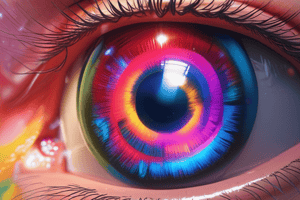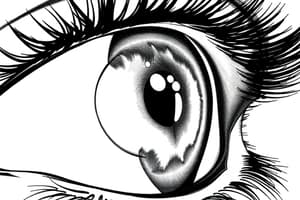Podcast
Questions and Answers
What type of photopigment is primarily found in rods?
What type of photopigment is primarily found in rods?
- Chololabe
- Iodopsin
- Erythrolabe
- Rhodopsin (correct)
What happens to the lens of the eye when focusing on a distant object?
What happens to the lens of the eye when focusing on a distant object?
- The lens becomes thicker
- The lens flattens (correct)
- The lens changes to a more rounded shape
- The ciliary muscle contracts
Which of the following statements about photoreceptors is false?
Which of the following statements about photoreceptors is false?
- Rods and cones are types of photoreceptors.
- Cones are generally more sensitive in dim light than rods. (correct)
- Photoreceptors hyperpolarize in response to light.
- Photoreceptors are involved in visual acuity.
What feature is associated with saccadic eye movement?
What feature is associated with saccadic eye movement?
What is the role of photopsins in the eye?
What is the role of photopsins in the eye?
What happens to the ciliary muscles and lens during far vision?
What happens to the ciliary muscles and lens during far vision?
Where is the aqueous humor primarily produced?
Where is the aqueous humor primarily produced?
What is the main function of the vitreous humor?
What is the main function of the vitreous humor?
How does the aqueous humor help in maintaining ocular health?
How does the aqueous humor help in maintaining ocular health?
Which of the following statements is true regarding the drainage of aqueous humor?
Which of the following statements is true regarding the drainage of aqueous humor?
What is primarily responsible for maintaining intraocular pressure?
What is primarily responsible for maintaining intraocular pressure?
Which structure is located between the cornea and the lens?
Which structure is located between the cornea and the lens?
What change occurs to the lens during near vision?
What change occurs to the lens during near vision?
Flashcards
Far Vision
Far Vision
The ciliary muscle relaxes, allowing the suspensory ligaments to pull on the lens, making it thinner and flatter. This allows for clear vision of distant objects.
Near Vision
Near Vision
The ciliary muscle contracts, reducing tension on the suspensory ligaments. This allows the lens to become thicker and more rounded, enabling clear vision of nearby objects.
Suspensory Ligaments
Suspensory Ligaments
Fibrous strands that connect the ciliary muscle to the lens, playing a crucial role in lens accommodation.
Aqueous Humor
Aqueous Humor
Signup and view all the flashcards
Aqueous Humor Production
Aqueous Humor Production
Signup and view all the flashcards
Aqueous Humor Drainage
Aqueous Humor Drainage
Signup and view all the flashcards
Vitreous Humor
Vitreous Humor
Signup and view all the flashcards
Vitreous Humor Production
Vitreous Humor Production
Signup and view all the flashcards
Rhodopsin
Rhodopsin
Signup and view all the flashcards
Iodopsin
Iodopsin
Signup and view all the flashcards
Accommodation
Accommodation
Signup and view all the flashcards
Saccadic Eye Movement
Saccadic Eye Movement
Signup and view all the flashcards
Visual Acuity
Visual Acuity
Signup and view all the flashcards
Study Notes
Lens Accommodation
- Far vision: Ciliary muscle is loose, lens is flat.
- Near vision: Ciliary muscle is taught, lens is round.
- Suspensory ligaments: Hold the lens in place.
Eyeball Anatomy and Fluid
- Aqueous humor:
- Location: Anterior and posterior chambers, between cornea and lens.
- Function:
- Nutrient delivery to avascular parts (cornea and lens).
- Waste removal from cornea and lens.
- Maintains intraocular pressure (IOP).
- Production: Ciliary body epithelium filters blood plasma.
- Drainage: Trabecular meshwork, Canal of Schlemm, back into bloodstream.
- Vitreous humor:
- Location: Posterior segment, between lens and retina.
- Function:
- Maintains eye shape and holds retina in place.
- Allows light to pass through to retina.
- Cushions the retina.
- Production: Mostly formed during embryonic development, minimal after birth.
- Drainage: Does not drain significantly.
Photoreceptors and Photopigments
- Photoreceptors: Specialized cells that transduce light into electrical signals.
- Photopigments: Molecules that absorb light.
- Sensitivity: Dim light = high sensitivity (rods), bright light = low sensitivity (cones).
- Iodopsin: Photopigment in cones; Responsible for color vision.
- Rhodopsin: Photopigment in rods; Responsible for night vision.
- Photopsins: Different types (erythrolabe, chlorolabe, cyanolabe) for different colours in cones.
- Retinal (vitamin A): Part of rhodopsin, derived from carotene.
- Scotopsin (glycoprotein): protein part of rod photopigment.
Lens Shape and Accommodation
- Closer objects: Round lens, contracted ciliary muscle.
- Far objects: Flat lens, relaxed ciliary muscle (objects further than 20 feet away).
Photopigment Bleaching and Regeneration
- Bleaching: Light-induced changes in photopigment.
- Hyperpolarization: Photoreceptors respond to light by hyperpolarizing (decreasing their membrane potential).
- Regeneration: Photopigments regenerate constantly in order to continue receiving light stimulus.
- Cones and rods: Different photoreceptors respond to various wavelengths of light.
Eye Movement
- Saccadic eye movement: Rapid, jerky movements.
Other Key Concepts
- Visual acuity: Sharpness of vision, related to lens accommodation.
- Accommodation: The ability of the eye to focus on objects at different distances.
- Depolarization/Hyperpolarization: Changes in membrane potential in response to light stimulation.
- After-imaging: Persistence of an image after the stimulus is removed.
Studying That Suits You
Use AI to generate personalized quizzes and flashcards to suit your learning preferences.




